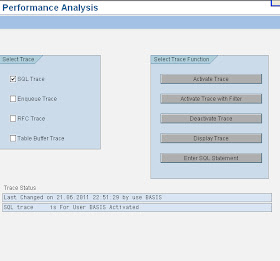This article answers the following queries :
- What are the different types of traces in SAP ?
- How to activate a Trace for a user in SAP system ?
- How to do performance analysis in SAP system ?
What are the different types of traces in SAP ?
- SQL Trace (Trace for SQL statements)
- Enqueue Trace (Trace for enqueue/lock requests, waiting etc)
- RFC Trace
- Table Buffer Trace
How to activate a Trace for a user in SAP system ?
Goto transaction ST05 and you will get the below screen :
Select the type of trace you would like to activate and press activate trace to start tracing.
Please find below functionality of various functions in the above screenshot :
Activate Trace : This is used to activate the trace for the same user who is starting the trace
Activate Trace with Filter : This functionality is used to trace the activity of a different user(other than the user who is starting the trace) and filter can be done to trace a specific transaction or program.
Display Trace : This functionality is used to display trace
Click on tick mark to display the trace
Click on Yes to display the trace as below:
Enter SQL Statement : This functionality is used to analyse an SQL statement
Click on this pushbutton to view the below screen :
Trace Status : This area is used to inform about the status of the trace at that point of time like traces activated, deactivated etc









Thanks,
ReplyDeleteNow i can able to activate tracing
Please write on object level authorization
Thanks a lot Guru...Definitely will write an article on object authorisation very soon
ReplyDeleteThanks,
ReplyDeleteThese articles are needful and very helpful for us.
Thanks lot for U......
Plz make it more articles.
Thanks Veera for your sweet comments. Definitely will post more articles :-)
ReplyDeletehello Durga,
ReplyDeleteThanks a lot for these kind of stuff, you are simply superb.... I dont know about others but you really helped me in understanding the basics. I want you to release a book. God bless you and ur family!!!!!!!!!
Hi Friend....Thanks a lot for your wishes. Your post is really motivational. Definitely will plan to release a book at the earliest :-)
ReplyDeleteshukran shukran
ReplyDeleteHy Durga, Can you please provide a step by step procedure of OS & DB Migration... That would be really helpful..
ReplyDeleteThanks in advance. Keep rocking..
Hi Joshua...As of now, i donot possess those steps. Will try to post at the earliest..Thanks for your nice comments
ReplyDeleteHi Durga Prasad
ReplyDeleteHow to use ST03N in my case it doesn't show the active instance of SAP in the list and if any period (Day, Week or Month) If we choose it says Wrong Period
I am using SAP ECC 6.0 SR2 IDES
Or Is it that we cant use this T-Code in Training Software (IDES)
Would request you if you can guide in a step by step manner how to use and specially how to add the instance in it.
Thanks
Ale
Hi sir , i got ABAP dump i.e OPEN_DATASET_NO_AUTHORITY,please tell me the solution how to solve this dump.
ReplyDeleteRegards
karthik
Hi karthik,
ReplyDeletePlease provide bit more details like while running which transaction, you are facing this issue.
Thanks,
Prasad
hi karthik, could u explain me the step by step process how to send an email by attaching a file using sbwp(business workplace)
ReplyDeleteHi Dura prasad pls give reply to my post
ReplyDeletei am getting error while add data file to table space PSAPSR3 at last it showing error new data file should in sapdata sub directory i checked path it was correct give solution or guide me to resolve the issue..
thank u
Hi,
ReplyDeleteYou have explained how to take a trace but please give explanation for performance tuning.
Rgds
GOOD
ReplyDeleteThanks a lot Durgaprasad. Your blog helped me a lot.
ReplyDeleteKeep up the good work.